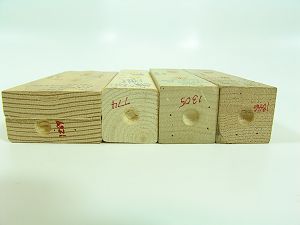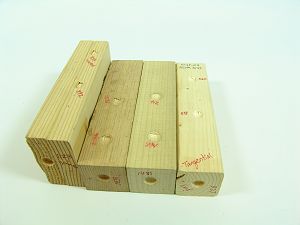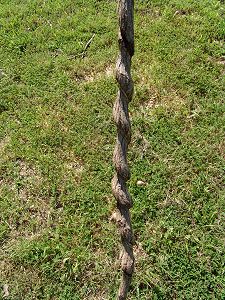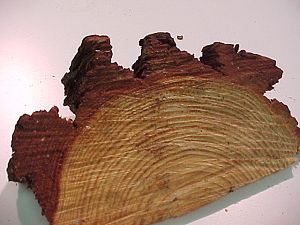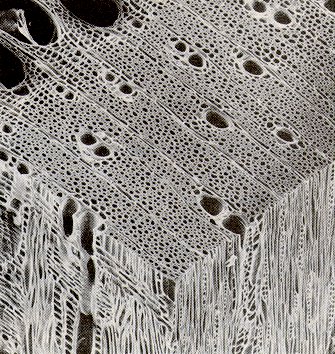
Wood Cells
simplified structure of the cell wall showing orientation of microfibrils in each of the major wall layers
yellow pinefrom The Science and Technology of Civil Engineering
Materials, J.F. Young, et al., Prentice Hall, 1998.Koch, P. 1972b. Utilization of the southern pines. II. The raw material.
USDA Forest Service Agricultural Handbook No. 420. 926 pp.
In summary, the mechanical properties of wood relate directly to the shape and size of its cells, and to the properties of the composite-like cell walls. Loaded along the grain, the cell walls are loaded in simple tension or compression, and the properties scale as the density. But across the grain, the cell walls bend, and then the properties depend on a power (3/2 to 2) of the density. That, plus the considerable anisotropy of the cell wall material, explain the enormous difference between the modulus, strength and toughness along the grain and across it. from Engineering Materials 2: An Introduction to Microstructures, Processing and Design, M.F. Ashby & D.R.H. Jones, Pergamon, 1994, p. 263.
Cell Wall
from Wood: Nature's Cellular, Polymeric Fibre-Composite,
J.M. Dinwoodie, The Institute of Metals, 1989, p. 13.
from Engineering Materials 2: An Introduction to Microstructures, Processing
Category Material Structure Approx. wt % fibres cellulose crystalline 45 matrix lignin amorphous 20 hemicellulose semi-crystalline 20 water dissolved in the matrix 10 extractives dissolved in the matrix 5
and Design, M.F. Ashby & D.R.H. Jones, Pergamon, 1994, p. 258.
Cellulose is the primary component of the cell wall. Furthermore, it is the single most abundant organic chemical in nature. It is one of the few natural compounds that retain the same structure regardless of whether its source is wood, cotton, grass, or a host of other plants. Structurally cellulose is the simplest of the cell wall components -- a linear polymer of glucose units. Biosynthetic polymerization is such that the basic polymeric unit of two combined glucose constituents is "stretched" to almost its maximum dimension. The number of glucose units in a cellulose molecule (degree of polymerization) ranges from a few to as many as 15,000, depending on its location within the cell wall.
from Mechanics of Wood and Wood Composites, J. Bodig & B.A. Jayne, Krieger Publishing, 1993, p. 5.(C6H10O5)n
Cellulose nanocrystals 'have strength of steel'
International Conference on Natural Fibers
Category Material Density
(Mg m-3)Modulus
(GPa)Strength
(MPa)fiber carbon, type 1 1.95 390 2200 carbon, type 2 1.75 250 2700 e-glass 2.56 76 1400-2500 cellulose 1.61 60 1200 kevlar 1.45 125 2760 matrix epoxies 1.2-1.4 2.1-5.5 40-85 polyesters 1.1-1.4 1.3-4.5 45-85
Sapwood vs Heartwood
sapwood - store food, transport liquids, accepts wood preservative
heartwood - inactive cells, darker, more decay resistant
Earlywood (springwood) vs Latewood (summerwood)
growth rings with growing seasons
Managed tree plantations (genetic engineering, thinning, protein and fertilization) has resulted in greater proportions of earlywood. Difference in moduli found to be as high as seven.
"Mesostructure Elastic Properties in Loblolly Pine" by S. Cramer
Softwood vs Hardwood
softwood hardwood
- larger, longer cells
- water transported by cells
- large-diameter vessels
- water transported by these vessels
see The Tree Collection for more cellular images
















